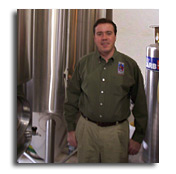The Roving Brewer: Episode 1
October 25, 2006 at 12:00pm
 This is the first article in a series of discussions with our roving brewing expert, Eric Watson.
This is the first article in a series of discussions with our roving brewing expert, Eric Watson.After completing much research Eric was mulling over revelations about some long held brewing concepts. The concepts he discusses have bearing on professional brewers just as much as homebrewers. It may even surprise you, or at least strike you as different. So but on your seatbelt...here we go:
1) First Wort Hopping:
Don't ! This was a technique adopted by German brewmasters in the early 80's under the premise that it produced a "finer bitterness" than traditional early kettle hopping. NONE do it anymore! The reason is that they found out that this method of hopping is detrimental to head retention. The current technique is to begin hop charges 10 minutes after the onset of a vigorous boil. Weihenstephan's professors contend that if you perceive a harshness in your bittering additions, it is a hop variety or crop issue, not the application of the hops themselves. This rings true in the traditional sense since German brewers have always maintained that the use of low alpha varieties (nobles) produces a finer hop character in beer.
2) Step mashing as a method of increasing dextrines to increase the viscosity (mouthfeel) of beer:
Even though it is true that this mash technique does increase dextrins as an end result, it has been discovered that the perception of rich body in beer by humans is not related to dextrin content, but rather is a psychological reaction to some yet to be identified property in beer. They determined this through extensive blind trials where identical beers were sampled, half as-is and half with added dextrins. 100% of the respondants rated the body of the beers as identical!
Now what does this mean to us as brewers? With the fully modified malts available to us today, it is pointless to do anything other than a single step infusion mash. And, with the great excess of enzymes that are present in our malts (remember almost all fully modified malts are designed for big brewers with high adjunct rates), this means conversion can be achieved much faster than once believed. The current recommendations for all fully modified malts is a mash at 68~70C/154~158 with a pH of 5.3 for only 20 minutes prior to recirculation until the runnings are clear. Then sparge with 168 degree water, stopping the runnings at 2.5P/1.010SG. Then top up to kettle volume. Running beyond this gravity floor will only extract tannis and lipids. The idea here is to maximize extraction while minimizing grain contact. This goes a long way toward the elimination of tannins (harsh, husky flavors) and lipids (head killers and can create clarity issues) being entrained in the wort. The complete science regarding this technique is outlined in both Charlie Bamforth's and Michael Lewis's new books that are available from the Association of Brewer's publishing arm, Brewer's Publications. You can order them online from www.beertown.org.
3) Wort Aeration:
If possible, don't! The reason is that it is not the wort that needs the oxygen, it is the yeast. By oxgenating the wort instead of the yeast starter, it will cause an over production of cells due to the excessive oxygen presence. This then leads to the production of unwanted esters and higher alcohols that will compromise beer flavor.
When oxygenating starters, you cannot use pure O2... the reason is that the uptake occurs too fast and without a dissolved O2 meter ($$$), you cannot tell when to stop. The way to properly do this one is to aerate using a high pressure aquarium pump, sterile air filter and a stainless steel aeration stone, all of which are redily available. It is virtually impossible to over-aerate using air, so you will avoid oxygen toxicity problems that will occur if trying to do this with pure oxygen.
I know these topics are contrary to what most people have learned and read about (me included!) and particularly go against traditionalist notions. In the case of the 20 minute, single rest, high temperature infusion mashing technique, remember that all of the mandates we learned were based historically when barley varieties and malting was very poor. This reality required heroic steps to produce a good wort, but they have been proven to no longer be necessary, and in some ways, detrimental.
Upon returning from this recent training, I instituted these practices in my brewery and they definitely work. My biggest concern was centered around the mashing regimen change. I kept obsessing that the short mashing time might lead to a reduction in wort color or hue. Nope! Not only did the wort turn out great, but I chopped 70 minutes out of my day!
Give these a whirl. I think you will be pleased with the results and you didn't have to pay thousands of dollars to find out like I did. Some of you probably have questions. The next installment of The Roving Brewer will address some of those questions so stay tuned!
Here are more articles from The Roving Brewer:
The Roving Brewer: Episode Two
The Roving Brewer: Episode Three
The Roving Brewer: Episode Four
The Roving Brewer: Episode Five
Comments on this article?
